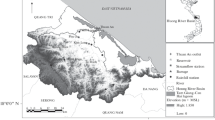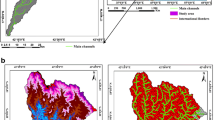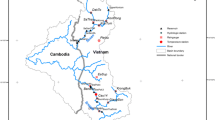Abstract
Dams are built in arid regions across watersheds for flood control among other purposes. Capacity-elevation (C-E) curves are vital for reservoir routing and dam operation. Different models are available for representing C-E relationships. Power and logarithmic laws are evaluated and tested for reservoir routing. The evaluation is based on the analysis of 136 reservoirs across different regions of Saudi Arabia (SA). The analysis revealed that 75.7% of the reservoirs are of flood plain foothill type. A case study on Al-Lith dam basin is utilized for application based on measured events. The resulting routed outflow hydrographs showed that the logarithmic law is better to represent the reservoir than the power law. With respect to the climate change effect, the results show that the predicted rainfall from Representative Concentration Pathways scenario (RCP4.5) increased by about 20 to 31.4% from 5 to 100 years return periods respectively with an average of 27%. While for scenario RCP8.5, the predicted rainfall increased by 42% to about 55% from 5 to 100 years return periods respectively with an average of 49%. For the RCP4.5 scenario, the peak flows, Qp, and volumes, W, increased by an average of 69% and 67% respectively. While for the RCP8.5 scenario, the same parameters increased by an average of 139% and 134% respectively. The effect of transmission losses in the results seems to be minor with respect to climate change signal (for RCP4.5, Qp and W are lowered on average by 2% and 0.5% respectively, and for RCP8.5, Qp and W are lowered on average by 4.5% and 1.3% respectively). The results of this research recommend to use the logarithmic law and to take into account the effect of climate change on future dam projects in SA.









Similar content being viewed by others
References
Ahmad B, Rasul G (2018) Statistically downscaled projections of CORDEX South Asia using quantile map** approach over Pakistan region. Int J Global Warming 16(4):435–460
Albishi M, Bahrawi J, Elfeki A (2017) Derivation of the unit hydrograph of Al-lith basin in the south west of Saudi Arabia. Int J Water Res Environ 6(1):50–57
Arnbjerg-Nielsen K (2012) Quantification of climate change effects on extreme precipitation used for high resolution hydrologic design. Urban Water J 9(2):57–65
Borland WM, Miller CR (1958) Distribution of sediment in large reservoirs. J Hydraul Div 84(2):1587.1–1587.10
Chow VT, Maidment DR, Mays LW (1988) Applied hydrology, international editions. McGraw-Hill, New York, pp 242–251
Chowdhury S, Al-Zahrani M (2013) Implications of climate change on water resources in saudi arabia. Arab J Sci Eng 38:1959–197. https://doi.org/10.1007/s13369-013-0565-6
Dames and Moore (1988) Representative basins study for wadis: Yiba, Habawnah,Tabalah, Liyyah, and Lith, Draft final report to the Ministry of Agriculture and Water. Kingdom of Saudi Arabia, Riyadh
Elfeki AM, Ewea HAR, Bahrawi JA, Al-Amri NS (2014) Incorporating transmission losses in flash flood routing in ephemeral streams by using the three-parameter Muskingum method. Arab J Geosci 8:5153–5165. https://doi.org/10.1007/s12517-014-1511-y
Elshorbagy A, Lindenas K, Azinfar H (2018). Risk-based quantification of the impact of climate change on storm water infrastructure, 32(1), 102-114
Giorgi F, Jones C, Asrar GR (2009). Addressing climate information needs at the regional level: the CORDEX framework. World Meteorological Organization (WMO) Bulletin, vol. 58, no. 3, pp. 58, 175
HEC (2000) Hydrologic modeling system: technical reference manual. US Army Corps of Engineers Hydrologic Engineering Center, Davis
Haghiabi AH, Salmian SS, Mohammadzadeh-Habili J, Mousavi SF (2013) Derivation of reservoir’s area-capacity equations based on the shape factor. Trans Civil Eng 37(C1):163–167
Jones CG, Ullerstig A, Willén U, Hansson U (2004a) The Rossby Centre regional atmospheric climate model (RCA). Part I: model climatology and performance characteristics for present climate over Europe. Ambio 33(4–5):199–121
Jones RG, Noguer M, Hassell DC (2004b) Generating high–resolution climate change scenarios using PRECIS. Exeter, Met Office Hadley Centre
Kamis AS, Bahrawi JA, Elfeki AM (2018) Reservoir routing in ephermal streams in arid regions. Arab J Geosci 11(6):106
Kite GW (1975) Confidence limits for design events. Water Resour Res 11(1):48–53
Kjellström E, Nikulin G, Hansson U, Strandberg G, Ullerstig A (2011) 21st century changes in the European climate: uncertainties derived from an ensemble of regional climate model simulations. Tellus A: Dynamic Meteorol Oceanogr 63(1):24–40
Li M, Tang X, Wu W, Liu H (2013) General models for estimating daily global solar radiation for different solar radiation zones in mainland China. Energy Conserv Manag 70:139–148
Macchione F, De Lorenzo G, Costabile P, Rezdar B (2016) The power function for representing the reservoir rating curve: morphological meaning and suitability for dam breach modeling. Water Resour Manag 30(13):4861–4881
Meehl GA, Covey C, Delworth T, Latif M, McAvaney B, Mitchell JFB (2007) The WCRP CMIP3 multi-model dataset: a new era in climate change research. Bull Am Meteorol Soc 88(9):1383–1394
Mohammadzadeh-Habili J, Heidarpour M, Mousavi S, Haghiabi AH (2009) Derivation of reservoir’s area capacity equations. J Hydrol Eng 14:1017–1023
Moore D. (1998). Representative basins study for wadis: Yiba, Habawnah, Tabalah, Liyyah and Lith, Final Report by Dames & Moore, Saudi Arabia to Ministry of Agriculture and Water, Riyadh, 1988
Moss RH, Edmonds JA, Hibbard KA, Manning MR, Rose SK, Van Vuuren DP, Carter TR, Emori S, Kainuma M, Kram T, Meehl GA, Mitchell JFB, Nakicenovic N, Riahi K, Smith SJ, Stouffer RJ, Thomson AM, Weyant JP, Wilbanks TJ (2010) The next generation of scenarios for climate change research and assessment. Nature 463(7282):747–756
O'Donnell T (1985) Direct three-parameter Muskingum procedure incorporating lateral inflow. Hydrol Sci J 30(4):479–496
O'Donnell T, Pearson CP, Woods RA (1988) Improved fitting for three-parameter Muskingum procedure. J Hydraul Eng 114(5):516–528
Monier E, Gao X (2015) Climate change impacts on extreme events in the United States: an uncertainty analysis. Clim Chang 131(1):67–81
Rahmanian MR, Banihashemi MA (2012) Introduction of a new empirical shape function to define sediment distribution pattern in dam reservoirs. Trans Civil Eng 36(C1):79–92
Räisänen J, Hansson U, Ullerstig A, Döscher R, Graham LP, Jones C (2004) European climate in the late 21st century: regional simulations with two driving global models and two forcing scenarios. Climate Dynam 22:13–31
Rajab R, Prudhomme C (2002) Climate change on water resources management in arid and semi-arid regions: prospective and challenges for the 21st century. Biosyst Eng 81(1):3–34
Rummukainen M, Räisänen J, Bringfelt B, Ullerstig A, Omstedt A, Willén U (2001). A regional climate model for northern Europe: model description and results from the downscaling of two GCM control simulations. Climate Dynamics, vol. 17, no. 5–6, pp. 17:339–359
Samuelsson P, Gollvik S, Kupiainen M, Kourzeneva E, van de Berg WJ (2015) The surface processes of the Rossby Centre regional atmospheric climate model (RCA4). Norrkö**, Sweden, SMHI, p 2015
Samuelsson P, Jones CG, Willén U, Ullerstig A, Gollvik S, Hansson U, Jansson C, Kjellström E, Nikulin G, and Wyser K (2011). The Rossby Centre regional climate model RCA3: model description and performance, Tellus Ser A 63(1): 4–23
Strandberg, G, Kjellström E, Poska A, Wagner S, Gaillard MJ, Trondman AK, Mauri A, Davis BAS, Kaplan J O, Birks HJB, Bjune A E, Fyfe R, Giesecke T, Kalnina L, Kangur M, van der Knaap WO, Kokfelt U, Kuneš P, Lata\l owa M, Marquer L, Mazier F, Nielsen AB, Smith B, Seppä H, and Sugita, S (2014) Regional climate model simulations for Europe at 6 and 0.2 k BP: sensitivity to changes in anthropogenic deforestation. Clim Past 10:661–680. https://doi.org/10.5194/cp-10-661-2014
Syed FS, Latif M, Al-Maashi A, Ghulam A (2019) Regional climate model RCA4 simulations of temperature and precipitation over the Arabian Peninsula: sensitivity to CORDEX domain and lateral boundary conditions. Clim Dyn 53(11):7045–7064
Taylor KE, Stouffer RJ, Meehl GA (2012) An overview of CMIP5 and the experiment design. Bull Am Meteorol Soc 93(4):485–498
US Army Corps of Engineers HEC-HMS http://www.hec.usace.army.mil/software/hec-hms/
Wheater HS, Laurentis P, Hamilton GS (1989) Design rainfall characteristics for south-west Saudi Arabia. ProcInstCivEng 87(4):517–538
Acknowledgments
The authors, therefore, acknowledge with thanks the DSR for technical and financial support. The authors also would like to thank Mr. Abdullah Almalki for the preparation of the graphs.
Funding
This project was funded by the Deanship of Scientific Research (DSR), King Abdulaziz University, Jeddah, under grant no. (G-158-155-1440).
Author information
Authors and Affiliations
Corresponding author
Ethics declarations
Conflict of interest
The authors declare that they have no competing interests.
Additional information
Responsible Editor: Broder J. Merkel
Appendix
Appendix
The mass conservation equation for reservoir routing is given by the following:
where W(t) is the storage of the reservoir, I(t) is the inflow hydrograph upstream the dam, and O(t) is the outflow hydrograph downstream the dam passed over the spillway.
The spillway equation reads as follows:
where C is the discharge coefficient, B is the spillway width, Z is water depth measured from the reservoir bottom, and P is the spillway height measured from the reservoir bottom.
The storage term in Eq. (18) is required to be assessed. This term can be rewritten as follows:
where A(Z) is the surface area of the reservoir. Substituting Eq. (21) in Eq. (18) yields the following:
The two methods presented earlier (the power law and the logarithmic law) are used to quantify the surface area of the reservoir by differentiating Eqs. (1) and (2). Then substituting in Eq. (22) including Eqs. (19) and (20) for the reservoir outlet yields the following equations for the power law and the logarithmic law respectively presented in the paper (Eqs. 8 and 9).
Rights and permissions
About this article
Cite this article
Kamis, A.s., Al-Wagdany, A., Bahrawi, J. et al. Effect of reservoir models and climate change on flood analysis in arid regions. Arab J Geosci 13, 818 (2020). https://doi.org/10.1007/s12517-020-05760-6
Received:
Accepted:
Published:
DOI: https://doi.org/10.1007/s12517-020-05760-6




